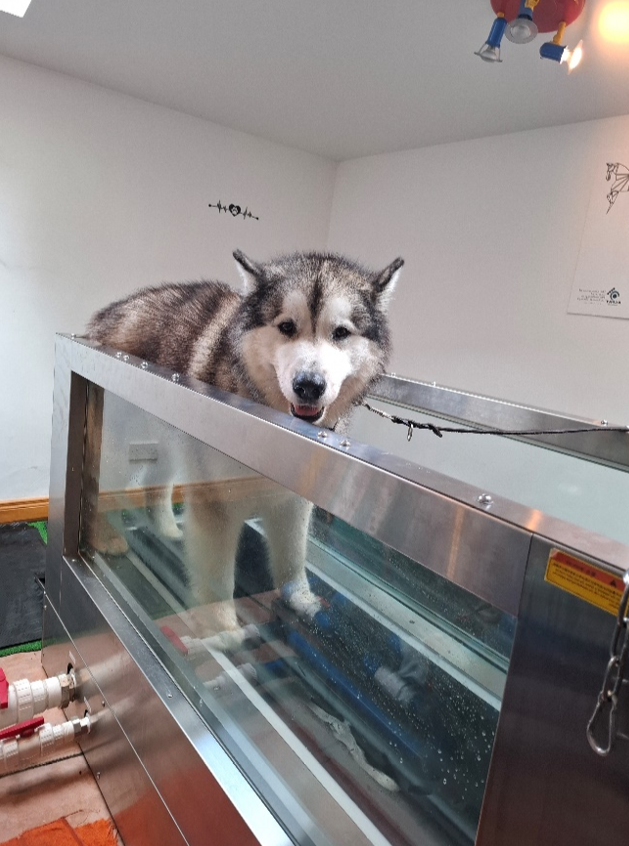Physiotherapy and hydrotherapy for management of hip dysplasia
- Vet
- May 14
- 3 min read
Hip dysplasia is a progressive disease where excessive joint laxity leads to degenerative changes in the joint with increased wear on the articular cartilage and eventual osteoarthritis. Physiotherapy and hydrotherapy are important in the long-term management of hip dysplasia.

Aims of rehabilitation
Signs of hip dysplasia in dogs include reduced exercise tolerance, limping after exercise, difficulty going up and down stairs, slowness with rising from laying down. During the initial physiotherapy assessment findings include abnormal gait pattern, plus or minus lameness, reduced weight-bearing on the affected limb, reduced size of pelvic and leg muscles, pain when touched in the affected area or during certain movements or postures and reduced range of movement (ROM). Your dog may exhibit all of or just a few of these clinical signs. Rehabilitation aims to address these and to maintain and/or reduce disease progression. .
Physiotherapy Aims include :
Reduce pain
Strengthen the affected muscles
Improve and maintain soft tissue flexibility
Improve and maintain ROM
Enhance gait patterning
Physiotherapeutic treatment options
Targeted exercises specifically for the gluteal muscles
Balance and coordination exercises
“Hands-on” therapy such as massage and basic stretching for pain relief and improving flexibility
Pain relief might be provided using lase therapy and ice

Hydrotherapy treatment options
· Hydrotherapy underwater treadmill is a useful tool for strengthening muscles and improving gait patterns. The buoyancy of the water provides support to the body which in turn reduces the load on the affected joints whilst exercising the necessary muscles.
·

Any physiotherapy programme which is prescribed for your dog is constantly re-evaluated and progressed based on the response to treatment. Owner participation is key as so much of the therapy is done at with the home exercise program on a daily basis.
Surgical management of hip dysplasia
Should your dog require surgery to address hip dysplasia, rehabilitation must be implemented post-operatively.
In the initial stages (24 hours-2 weeks) physiotherapy is used to address any possible swelling, reduce pain, maintain soft tissue flexibility and muscle mass. Physiotherapy tools might include cold therapy myofascial release, laser, joint range of motion exercises, stretches and careful limb loading exercises.
Following this phase (2 weeks – 6 weeks) more progressive exercises are utilised to improve functional movement, balance and coordination and hind limb muscle strengthening. At this stage as well as land-based exercises being progressed, hydrotherapy can be introduced using underwater treadmill therapy.
Following a 6-week post-operative assessment by the orthopaedic surgeon, the physiotherapy exercises can again be progressed and more active exercises involving hills and inclines, alternating speeds and change of direction are introduced.
The table below outlines an example hip dysplasia rehabilitation plan:*
*Please note that rehabilitation plans should only be followed under the guidance of a qualified rehabilitation professional, who will be able to provide a tailored plan based on the individual patient’s rehabilitation needs.
Timescale | goals | Treatment options |
0-2 weeks | Reduce Pain and swelling Reduce muscular guarding and maintain soft tissue flexibility Allow careful limb loading |
|
2-4 weeks | Increase muscle mass Progressive limb loading Maintain soft tissue length and flexibility Management at home | · Low-level exercise programme · Controlled exercise · neuromuscular electrical stimulation · Stretches and passive range of motion · Advice regarding home environment temporary adaptations and handling with sling |
4-6 weeks | Increase exercise tolerance Core stability | · pole work, gradients, steps and walking over different terrain. · Balance and co-ordination exercises · Hydrotherapy treadmill |
6-12 weeks | Improve functional movement Continue to increase exercise tolerance Continue hip stability | · Continue as above |
12+ weeks | Return to full function or establish deficits and advise re long-term management. | · Return to off lead exercise gradually · Long term management strategies |

Comments